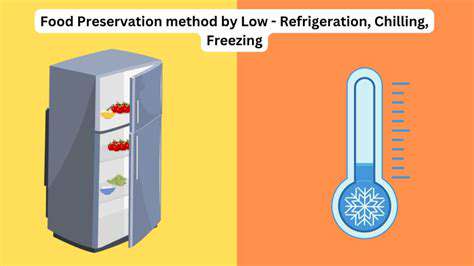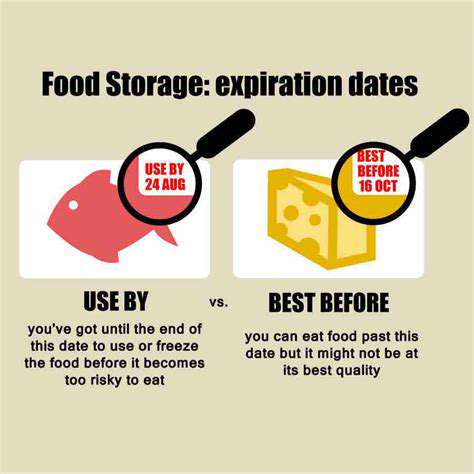Preventing Food Spoilage: Tips for a Longer Shelf Life
Jul 08, 2025 / btwgardenmachine/
Temperature plays a critical role in slowing down or halting the growth of microorganisms. Lower temperatures, generally, create a less favorable environment for microbial growth, slowing down the decomposition process. Refrigeration, for instance, significantly reduces the rate of food spoilage. Proper temperature control is essential in preventing the rapid multiplication of bacteria and other harmful agents.
Freezers offer an even more effective way to preserve food by lowering temperatures to a point that halts microbial activity almost entirely. While freezing does not completely eliminate all microorganisms, it effectively inhibits their growth and preserves the food's quality for extended periods. However, freezing can also affect the texture and taste of certain foods.
Maintaining Proper Humidity and Air Circulation
Controlling humidity is another crucial aspect of food preservation. High humidity can promote the growth of mold and bacteria, while excessively dry conditions can lead to dehydration and nutrient loss. Maintaining the correct moisture level is vital for preserving the freshness and quality of fruits, vegetables, and other perishable items. Appropriate storage solutions such as airtight containers or humidity-controlled environments can help maintain optimal conditions.
Proper air circulation is equally important. Stagnant air can trap moisture and create ideal conditions for mold and bacteria. Using well-ventilated storage containers or allowing for proper air circulation within your refrigerator can prevent these issues. By understanding how air circulation impacts food spoilage, you can implement better storage techniques that maintain the freshness of food longer.
The Role of Light and Oxygen in Food Spoilage
Light exposure can accelerate the degradation of certain foods, particularly those rich in vitamins and antioxidants. Direct sunlight can cause significant damage to the quality of fruits, vegetables, and other light-sensitive foods. Storing these items in dark containers or areas can help prevent this form of spoilage. Proper storage techniques often involve minimizing light exposure to extend the lifespan of the food.
Oxygen can also contribute to food spoilage. Some foods are particularly susceptible to oxidation, leading to changes in color, texture, and flavor. Using airtight containers or vacuum sealing can help reduce oxygen exposure, preserving the quality and extending the freshness of these foods.
Proper Handling and Storage of Specific Foods
Different types of food have varying needs when it comes to storage. For example, fruits and vegetables require specific humidity levels to maintain their freshness. Meats and poultry need proper refrigeration to prevent bacterial growth and must be handled with extreme caution to avoid cross-contamination. Understanding these specific needs and implementing appropriate storage techniques is crucial to extending their shelf life and preventing foodborne illnesses.
Knowing how to properly store various types of food, from delicate greens to hearty grains, is essential for preventing spoilage and maximizing the use of your food resources. Proper storage procedures for each food type, such as refrigerating dairy products or freezing leftovers, are crucial in preventing spoilage and maintaining food safety.
Controlling Temperature Fluctuations: A Key to Preservation

Understanding Temperature Fluctuations
Temperature fluctuations are a common occurrence in various environments, from homes and offices to industrial settings and even the natural world. Understanding the causes and consequences of these fluctuations is crucial for effective management and control. These variations can significantly impact comfort levels, product quality, and overall efficiency. Accurately measuring and monitoring these changes is the first step towards implementing effective control strategies. Predicting future temperature trends can also aid in proactive measures.
Several factors contribute to temperature fluctuations. External weather conditions, internal heat generation from appliances or people, and inadequate insulation can all play a role. Understanding these contributing elements allows for the development of targeted solutions. Recognizing the interplay of these factors is essential for developing precise and effective temperature control strategies.
Methods for Temperature Control
Numerous methods exist for controlling temperature fluctuations. These methods range from simple adjustments to sophisticated technological solutions. For example, in residential settings, adjusting thermostats or using fans can help regulate indoor temperatures. In industrial settings, advanced climate control systems with sensors and automation are often used to maintain precise temperature ranges for specific processes. Implementing insulation measures in buildings can also significantly reduce temperature variations.
Active temperature control systems, often utilizing sophisticated algorithms and sensors, are employed in many industrial and commercial settings. These systems can react dynamically to changes in the environment, ensuring optimal temperature conditions are maintained. Precise control of temperature is critical for maintaining consistent product quality and efficiency in many manufacturing processes. These sophisticated systems often incorporate feedback loops to continually adjust settings based on real-time data.
Consequences of Uncontrolled Fluctuations
Uncontrolled temperature fluctuations can lead to a variety of undesirable consequences. In homes, inconsistent temperatures can cause discomfort and energy waste. In industrial settings, fluctuating temperatures can negatively impact product quality, increase maintenance costs, and even compromise the safety of equipment. Significant temperature variations can lead to equipment failure and costly repairs in manufacturing environments. For example, inconsistencies in temperature during food processing can lead to spoilage and safety concerns.
Beyond the practical implications, uncontrolled temperature fluctuations can also have broader environmental impacts. Inadequate insulation in buildings leads to increased energy consumption and carbon emissions. In extreme cases, uncontrolled temperature variations can disrupt ecosystems and affect biodiversity. Therefore, effective temperature control strategies are essential for both practical and environmental reasons.

